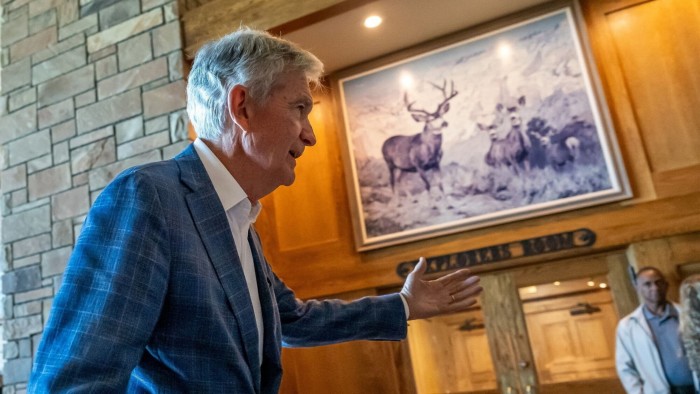Unlock the Editor’s Digest for free
Roula Khalaf, Editor of the FT, selects her favourite stories in this weekly newsletter.
The writer is president of Queens’ College, Cambridge, and an adviser to Allianz and Gramercy
The keynote address at the annual economic symposium at Jackson Hole has traditionally offered the leader of the world’s most powerful central bank an opportunity to share important strategic insights relating not just to monetary policy but also broader economic and institutional issues.
This was not what Jay Powell chose to do last Friday. Instead, the Federal Reserve chair opted for a risk-averse approach. He largely focused his remarks on the immediate outlook for monetary policy and characterised the revisions to the central bank’s Monetary Policy Framework as a mere evolution rather than a structural break from the 2020 version. That update — which included “the idea of an intentional, moderate inflation overshoot” — proved particularly ill-suited for the economic developments that followed.
Powell arrived at Jackson Hole under immense institutional pressure. For four years, inflation has persistently run above the Fed’s target, and recent data suggests it could edge higher again and that the jobs market is also weakening. Powell presides over a policy-setting Federal Open Market Committee showing signs of division, with the first dissent by two board governors in more than 30 years at last month’s policy meeting. All this unfolds as the US central bank faces deepening political pressures, including unproven allegations from the Trump administration last week targeting a serving board member.
Powell began his speech by providing markets with what they wanted to hear. He noted that “the baseline outlook and the shifting balance of risks may warrant adjusting our policy stance”. He went on to state that “downside risks to employment are rising” and that those risks can materialise “quickly in the form of sharply higher lay-offs and rising unemployment”. Stock, bond and other asset prices surged, with traders largely ignoring the inflation-related qualifications that followed in the speech.
What Powell did not do was spend enough time addressing the structural evolution of the economy, including the labour market, which was the stated subject of this year’s symposium. This risk-averse approach should not have been a surprise given the chair’s heavy reliance on backward-looking data for policy formulation.
The second primary focus of Powell’s speech was on the results of the periodic revision of the Monetary Policy Framework, or to use his phrasing, “how we pursue our dual mandate” — to deliver stable prices and maximum employment. His characterisation of the changes as evolution again underscored how a backward-looking approach had overly influenced the prior revision in August 2020. The core tenets of that revision proved largely irrelevant shortly after their announcement.
In his summary of the framework, Powell avoided addressing in detail an issue on which he has been repeatedly criticised — the need for clearer communication, especially in the summaries of FOMC meetings and forward policy guidance. He also reiterated that the Fed had no interest in revisiting the appropriateness of its 2 per cent inflation target. This position contrasts with the structural changes now buffeting the American economy such as supply chain restructuring, labour market changes and the rewiring of international trade.
Recommended
The narrow approach taken by Powell was a missed opportunity. First, it failed to provide a moment for reflection on his eight years as Fed chair. Second, it offered few insights into the policy implications of the structural changes rippling through the economy. Third, by coming across as speaking primarily about the upcoming September policy meeting, it fuelled the behavioural biases in markets that favour the urgent over the important.
That said, Powell avoided escalation of the heated political debate that surrounds the Fed, choosing not to address the issue of central bank independence. He also stayed silent on the allegations against his colleague on the board that prompted President Donald Trump to say he would fire the Fed governor if she did not resign.
In the end, Powell’s final Jackson Hole speech was not an exercise in explaining strategy and lessons learnt but a tactical manoeuvre. Faced with a politically embattled institution and a challenging economic outlook, he opted to provide markets with a near-term signal. He ceded the opportunity to address the more profound structural questions confronting the economy. By kicking the can of strategic vision down the road, and by avoiding any mention of reforms to the Fed, he has left it for his successor to address key issues facing the world’s most influential central bank.



